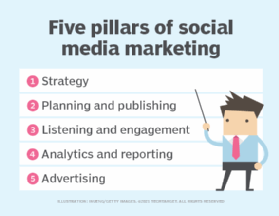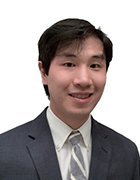
Getty Images
8 reasons why blogs are important for businesses
Businesses of all sizes can make blogging part of their marketing strategy. Blogging can increase website traffic, build trust with customers and expand a company's brand.
Marketing is constantly changing and using blogs as part of a marketing strategy is one way for organizations to reach current or potential customers -- no matter the type or size of the business.
Blogs make it easier for customers to find businesses through Google. Blogs also give customers a better understanding of a company and product. And by using a multichannel marketing strategy, blogs offer another touchpoint with customers.
Around 60% of people read blogs at least once a week, according to HubSpot. Small businesses and large corporations can create informative content for readers for little to no cost.
Here are eight reasons why blogs are important for businesses.
1. Drive traffic to a website
Blogs create relevant content to increase website traffic. Businesses with blogs get 55% more website visitors than those without one, according to a study by HubSpot Marketing.
Blogs are a great way to keep a website updated with fresh content. Readers want to know how to solve problems, and blogs can also tie in advice and a business service or product. In addition, blog posts can be the foundation of social media posts to reach customers. Organizations can post links to the blog on social media sites such as Facebook, LinkedIn and Twitter, giving readers a reason to click through to the business website.
2. Increase search engine optimization
Part of search engine optimization (SEO) is to drive organic traffic to a website. Search engine results are calculated by new content, the number of indexed pages and keywords. Businesses can improve all these areas and appear higher in the search engine result pages just by having a blog. The key to blogging is to provide relevant and quality content along with new posts.
By creating blog posts, businesses can also broaden their use of keywords. Organizations should use tools such as Ahrefs, Google Search Console, Semrush or Answer the Public for help determining keywords. But be mindful not to use a keyword too often. Google penalizes content for keyword stuffing.
By blogging about the industry, business, customers, products and events, related keywords will naturally be used in the content.
Read more tips for creating a content marketing SEO strategy here.

3. Grow email list
Email lists are a great way to interact with customers, but reaching new customers may be difficult if they have not heard of the business. Blogs can familiarize potential customers with a brand and pave the way for more people to subscribe to an email list. Customers are also more likely to trust email newsletters if they enjoy the blog content.
Read more about writing marketing emails.
4. Create content for social media
Social media provides an easy way for businesses to share content. Once a blog post is created, there is no need to rewrite it for social media. Simply provide a link to the blog on social and ask readers to share or like the post. Be sure to share across multiple social media platforms to reach more people.

Learn some other ways to use social media marketing to promote a business.
5. Attract new customers
With every blog post, there is another indexed page created, which can also help with SEO. Be sure to include calls to action on each of these pages.
Include concise instructions on what to do. For example, "Call us for an estimate," or "Book a free consultation today." Also, organizations should give customers a way reach them, such as a phone number, contact form or email address. Offer a free download or a place to sign up for more information to gather leads.
When writing blog content to new customers, a well-written blog may appear in a Google search for years -- providing new leads.
6. Build trust with the audience
Blog content enables businesses to share value and expertise. Blogs show current and potential customers what value a business provides.
Blogs can make a company appear more professional by showing leadership within an industry. Some of the best-performing web content includes videos, lists and how-to posts. Blogs can also answer common customer questions, such as how to use a product or solve a common issue with a product. Being able to increase the audience's trust, helps establish a business as more knowledgeable. Education is one of the top customer retention strategies to keep current customers.
When building trust, it's important to keep these digital marketing strategies in mind. They also apply to blog posts and include the following:
- Personalize content to readers.
- Use various channels to reach multiple generations.
- Show empathy in posts.
- Take advantage of marketing automation tools such as scheduling posts.
7. Expand the company's brand
Show the personal side of business to show customers they are more than just a number. Businesses can appear cold, but having a blog enables organizations to help audiences understand the day-to-day business and show their human side.
Sixty percent of consumers enjoy reading content from brands, according to a Demand Metric study. Eighty-two percent of customers also felt more positive about the brand after reading their content.
8. Educate and engage readers
Consumers like to be informed. Show how the business can be a solution to their problem. Readers can explore content from their homes and learn about a business they may have never thought about.
Use these touchpoints to engage readers and show expertise. However, the business should not always be the focus of every blog post. Instead, build trust with readers by being a source of reliable information.
If readers leave a comment under a blog post, interact with them by responding to their comment or question on the website. A blog is searchable for a longer time, so future readers can still view these interactions.
Follow these notable companies
The tech world is always evolving, and blogging is a great way to keep readers informed of critical changes.
One example of an effective blog is IBM. IBM breaks down customer needs into various blog categories such as AI, cloud infrastructure, business operations and security intelligence. IBM's blog shares advice, discusses the news and speaks to its tech audience.
Another example of writing to an audience is the Careful Cents blog, which provides direct answers to financial questions for startups and freelancers. This blog is successful because it provides answers and information that may be hard to find in other places.
Dotloop's blog covers topics about real estate automation, industry trends, product offerings and insight on working in the field. The blog breaks articles down by reader and role to provide expert-level information. They also offer a free download of transaction checklists to get potential customer information.
Check out these top IoT blogs to follow for more inspiration.







